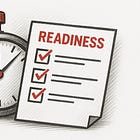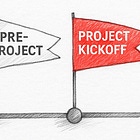Drone Points, Surveillance, Launching Projects & More
Profiles in Preparedness #41
You have a job to do—a project, an operation, an assignment—that can change your trajectory, set your organization apart, accomplish your mission, or serve the community.
Finishing well is what matters. But how you start sets the tone, and everyone around you feels it. A kickoff isn’t about bravado or hoping you’ll figure it out under pressure. It’s proof that you knew this day would come and you’re ready. It shows discipline: building a process, refining it through real use, and internalizing the lessons.
That’s what mastery looks like. Professionals don’t just “get things done.” They study the components, improve them, and raise the standard—faster, sharper, more thorough than before.
Yes, the real work comes after the kickoff. But how you launch determines the position your team will be in when it counts.
Inside The CP Journal
Here are some of the articles that were added to the site this week.
🔒For Academy Subscribers, we finished the “Project Kickoff” section of the Project Management in Emergency Management Playbook.
“When you build the ability to launch projects quickly and reliably, you become the person or the organization others turn to when something needs to be done, done well, and done yesterday. Your reputation and credibility increase, but so does your readiness to seize opportunities that others miss.”
🔒To finish the “Project Kickoff” section, we added articles for The Project Kickoff Meeting, Where Does the Project Manager Fit Into the Work?, and Building the Team That Delivers.
This Week‘s Reads
Here are a few standout reads from this week with insights, ideas, and perspectives that caught my attention.
Article | From Commander to Gardener. This essay uses George Washington’s dark winter at Valley Forge as a lens for leadership through Stanley McChrystal’s “Team of Teams” model. Facing a superior British force, Washington turned to Baron von Steuben, whose training reshaped ragtag militias into a disciplined army. But von Steuben didn’t simply import rigid European drills. He recognized that the colonists would have rejected that approach, instead tailoring his methods to the culture and people he was developing. The article connects this history to the Team of Teams principle of leadership as gardening and the need to shape the environment so that growth can flourish. To bring this metaphor to life, it offers eight essential principles that define this leadership approach.
Article | The N.Y.P.D. Is Teaching America How to Track Everyone Every Day Forever. This piece explores the expanding tension between technology, privacy, and public safety. On one side are legitimate concerns about civil liberties, privacy, and the indefinite storage of personal data gathered simply by existing in public. On the other hand, there is the expectation that law enforcement deliver safety flawlessly in a world where failures to “connect the dots,” like we saw in 9/11, are unacceptable. This is an article that will likely provoke reactions from both sides of the debate, which is why it’s worth reading. Surveillance isn’t going away, and the tradeoffs it forces deserve careful thought as we work to get left of bang.
Article | Ukraine’s Most Lethal Soldiers. This article digs into the way Ukraine has “gamified” war. Drone teams receive points for different types of targets—points that shift as priorities, risks, and threats evolve. Those points can be redeemed for tangible comforts, layering personal incentives on top of military pay. What struck me is the way this system decentralizes operations while staying connected to strategy. By adjusting incentives, commanders can align individual actions with organizational priorities without slowing operations through centralized planning. While brilliant, it’s also a reminder about the reality of modern war, where innovation has led to assigning points for death.
Article | Chaos Inside FEMA as Death Threats Distract From Hurricane Response. This reporting exposes how misinformation and conspiracy theories don’t just confuse the public—they actively undermine disaster response. FEMA staff have faced swatting incidents and even death threats, forcing the agency to divert resources and attention away from lifesaving operations. In any military or public safety mission, unity of effort is critical. When that unity fractures—when responders have to spend energy and resources countering falsehoods or protecting themselves instead of serving survivors—everyone loses. The mistrust sown by conspiracy theories erodes confidence and slows the very work communities depend on in a crisis. Preparedness isn’t only about plans and logistics—it’s also about trust. Rebuilding and maintaining that trust is now a daily part of the emergency manager’s mission.
Enjoyed This Issue? Pass It On and Go Deeper.
If this newsletter sparked ideas or challenged your thinking, share it with your network, a colleague, or on social media. Sharing is how we expand the community of professionals committed to getting and staying left of bang.
And if you want to go further, become a paying subscriber for exclusive access to:
The Tactical Analysis Course & behavioral analysis practice exercises
The Project Management in Emergency Management Playbook
The Operational Readiness Playbook that details how to build a watch office
And if you’re thinking about how to strengthen your organization's preparedness, that’s what we do. Whether it’s strategy development, assessments, planning, speaking events, or exercises, we help teams build the skills and strategies to stay ahead of the next challenge.




You’re outstanding at saying a lot with very few words. Something my rambling ass aspires to haha